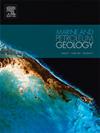Diagenetic evolution of the Cretaceous-Paleogene carbonate breccia, Cantarell, Mexico: Evidence from geochemical proxies
IF 3.7
2区 地球科学
Q1 GEOSCIENCES, MULTIDISCIPLINARY
引用次数: 0
Abstract
The Cretaceous-Paleogene (K-Pg) carbonate breccia in the Cantarell Field, Gulf of Mexico, consists of a fining-upward succession of breccias capped by an ejecta-rich seal layer. Petrographic analyses (cathodoluminescence, SEM, fluid inclusion microthermometry) and geochemical data (stable isotopes, elemental, trace elements) reveal a complex sequence of diagenetic processes that significantly impacted reservoir quality.
The breccia shows the highest porosity (∼9.4%) at the base of succession, decreasing upward. Six carbonate phases were identified including lime mudstone (C1), late blocky calcite (C2, 350 μm‒15 mm, concentric CL zoning), early replacement dolomite (D1, <50 μm, bright to dull CL), medium to coarse replacement dolomite (D2, 50–155 μm, cloudy cores with bright CL and clear rims with dull CL), planar-e dolomite cement (D3a, 80–180 μm), and saddle dolomite (D3b, 450–950 μm) with undulose extinction and CL zoning.
Trace element data provide clues about the fluid chemistry evolution. The low Sr content of D1 (94 ± 18 ppm), combined with its near-micritic grain size and the estimated δ18O values of the parent dolomitizing fluid (−4.9‰ to 0.3‰ SMOW), suggest an early-stage dolomitization at low temperatures of near-surface conditions that was driven by a mixture of meteoric and seawater. The Sr contents decrease from D1 to D2 (78 ± 19 ppm), suggesting progressive burial, which is supported by the relative decrease in δ18O values (D1 = −0.3 ± 1.8‰ VPDB; D2 = −4.3 ± 2.7‰ VPDB). The increase of [Sr] in D3a (265 ± 238 ppm) followed by a decrease in D3b (108 ± 40 ppm) correlates with tectonic uplift and subsequent burial. The δ13C values of D3b and δ18O values reflect higher fluid-rock interaction during deeper burial, supported by high Th values (105.7 ± 7.7 °C).
The shale-normalized REE patterns show that those of D1 and D2 mimic that of modern seawater and almost coincide with the C1 pattern, which suggests that C1 was likely the precursor. In contrast, the later phases (C2, D3a, D3b) show very low HREE concentrations, attributed to high fluid-rock interaction during tectonic uplift. This study of the K-Pg carbonate breccia provides a better understanding of its dynamic diagenetic history, shaped by fluid flow and tectonics, which critically influenced porosity and reservoir quality.
求助全文
约1分钟内获得全文
求助全文
来源期刊

Marine and Petroleum Geology
地学-地球科学综合
CiteScore
8.80
自引率
14.30%
发文量
475
审稿时长
63 days
期刊介绍:
Marine and Petroleum Geology is the pre-eminent international forum for the exchange of multidisciplinary concepts, interpretations and techniques for all concerned with marine and petroleum geology in industry, government and academia. Rapid bimonthly publication allows early communications of papers or short communications to the geoscience community.
Marine and Petroleum Geology is essential reading for geologists, geophysicists and explorationists in industry, government and academia working in the following areas: marine geology; basin analysis and evaluation; organic geochemistry; reserve/resource estimation; seismic stratigraphy; thermal models of basic evolution; sedimentary geology; continental margins; geophysical interpretation; structural geology/tectonics; formation evaluation techniques; well logging.
 求助内容:
求助内容: 应助结果提醒方式:
应助结果提醒方式:


